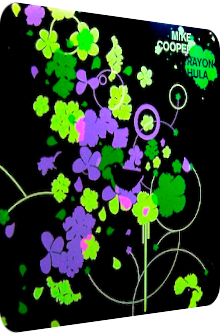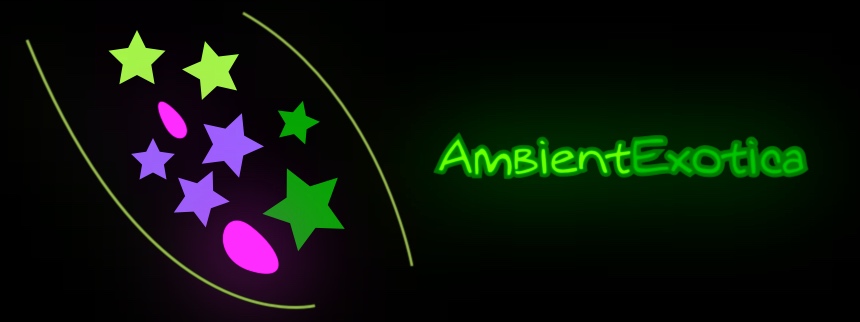
Mike Cooper
Rayon Hula
2004
When the obscure Don Tiare is able to turn Les Baxter’s string-heavy compositions into exotic escapist formations played by a quintet on The Music Of Les Baxter (1963) and even manages to gain access to exclusive sheet music plus the agreement of the luminary himself, chances are that further transmutations of similar primeness are possible in the world of Exotica. And what a coincidence, British guitar veteran Mike Cooper (born 1942) unleashes a particularly interesting artifact during his 40+ years spanning career that sports a feat similar to Don Tiare’s, although one would not expect it by the look of things.
Rayon Hula is released in 2004 on Cooper’s own Hipshot Records on CD and later on Cabin Records via two 10" LP’s, the twist being that it could alternatively be called The Music Of Arthur Lyman. Two main differences to Don Tiare’s work come to mind immediately: firstly, Rayon Hula is posthumously released, Arthur Lyman died in 2002 and was not involved in any way during the recording process. And secondly, Mike Cooper’s style differs in that he cuts sections out of Lyman’s multitudinous albums, loops and merges them with additional layers and intertwines them with his own steel guitar twangs and sampler tweaks. Two Mini Disc recorders and a Tascam four-track cassette recorder make it possible.
Lovers of field recordings have a, er, field day with this record as well, at least on two particular tracks, as the cavalcades of birds have all been recorded in Queensland, Australia. I know that sample-based music is a no-go for many an Exotica fan, and I can neither blame the respective listener nor convince him to give up his principles, but what I can do is write an in-depth review about the album’s enchanting sound washes. Arthur Lyman fans will get the most out of this record, no surprise here, but it is definitely hard to pinpoint the origin of the loops, as Lyman’s complete body of works is so large and the samples are spliced together cleverly. I was not able to designate the origin of even one sample, although I believe I can after all associate Lyman's original albums to certain sections. With these things in mind, Rayon Hula, I'm all yours.
A long-form piece of over eight minutes is the gateway to Rayon Hula. Called Mele Manu & Ho’okani Pila, it greets the listener with open arms. Mike Cooper places a long – and non-looped – field recording of various birds below seemingly backwards played mystery chimes on the vibraphone and accentuates the soothing hammock-friendly aura with weirdly elasticized cosmic strings, down-pitched piano chords by Alan Soares and raspy percussion vestiges as played by Harold Chang. Slow as molasses, complete with the archetypical interstitial artifacts between the frequencies, Mele Manu & Ho’okani Pila loses a great deal of its magic in this state which sports increasingly digital buzzes, jagged prongs and noisy protrusions, but as a whole showcases the endemic style and makes the listener acquainted with it. The follow-up Musa Shiya revs up the Space-Age coils even more, for they whirl in adjacency to the emaciated flute tones which resemble electric pianos due to their slowed down, prolonged physiognomy. A formerly ligneous Cha Cha Cha guiro now appears in arpeggiated form.
Side B opens with Kokoke Nalu and boasts a new, much more uplifting style and an overall better carved out song structure. A truly enchanting loop based on Arthur Lyman’s superimposed vibes is spiced with a programmed beat structure and Mike Cooper’s perfectly Hawaiian steel guitar twangs which float freely and probably unbeknownst to the Moebius atmosphere. To be honest, this track is much more resemblant to library music – or worse: lift music – than the polyhedric compositions of Mike Cooper or Arthur Lyman, but the flow is just right, the melody, while not hummable, undoubtedly soothing and silky, and the added steel guitar a lively element that ennobles the designedly artificial skeleton. Afterwards, Paumalu augments side B with an ecclesiastic three-note organ loop (which is probably just Lyman’s vibe), echoey percussion remnants and particularly spectral yet warmhearted guitar twangs. The former pieces were all densely layered, but here silence creeps in, as everything is more desiccate than before. This works to the song’s advantage which is particularly contemplative despite the occasional dazzling and skyrocketing frequency alternations.
Side C is bursting at the seams with four tracks which altogether show Mike Cooper’s humble beginnings during the age of psychedelia. The title track Rayon Hula presents a sulfurous embroidery of mercilessly warped and otherworldly guitar licks, enigmatic vibe tones which are genuinely frightening and alienating as well as a constant layer of fire crackles, popping hisses and semi-aqueous scents of haze. This one is for the fans of mallet instrumentalist Emil Richards’ Stones (1966), or better yet, Journey To Bliss (1968). Ho’omanau Nui is a tad warmer due to the staggering bass globs and their elasticized cooldown period, but otherwise unleashes the same technicolor diffusion; steel guitars hail from far behind, glockenspiels and vibe tones gyrate around a girdling field of crackles and blisters. I for one adore the wideness and echoey panorama, but have to admit that this hippiedom is not everyone’s cup of herbal tea.
While Typhoon Lagoon marries Space-Age arcana and ashenly glowing vibe tones with a tick-tocking beat structure, fugacious laser sounds and off-key steel guitar twangs, Mike Ohe finishes side C with a pandemonium or a witches’ dance loaded with exhaling stokehold clangs, marimba droplets and looped ukulele strums. Needless to say that it is next to impossible to pinpoint the origin of the loop, but my gut tells me it hails from Hawaiian Sunset (1959), one of Lyman’s most minimal and dreamiest albums.
Side D marks the glorious end of Mike Cooper’s increasingly weird and positively abhorrent excursion. Caught Inside (For Daniel Duan) is a clear leftover of side C and inherits the same elements and increasingly maddening legato drones of psychedelic movements, but sees their impetus decidedly tripled. Lyman’s vibraphone is not recognizable anymore, everything is whitewashed and streamlined, feels fuzzy and hands down danger-evoking. A very dry piece with a claustrophobic narrowness, its vinyl-like crackles and bouncing galactosamines are the only protrusions in the otherwise strictly legatofied phantasmagoria.
It is the task of the closer New Urban Hula Slide & The Tiki Bar Is Closed to take the listener back into, I wager, normal territories that reside much closer to the realness of the world as we know it, and what better way to depict reality than by injecting particularly vivid and unprocessed bird songs. Reversely played acoustic guitar arabesques are united with straightforward steel guitar notes, giving this piece a shuttling-shuffling appearance full of warmth. The second movement must be The Tiki Bar Is Closed and marks the literal downer and downfall of the album as Cooper throws threnodic tone sequences of utter disappointment into the ring: Lyman’s vibes and Soares’ piano. The birds may happily chirp, but that bar is indeed closed and will remain in that state whenever the song is played. Paradise lost?
Even though electronic gadgets and recorders were used in order to make Rayon Hula become reality, the album has soul and more than enough unique licks to offer enchantment. It not only respects the works of Arthur Lyman which themselves are mostly renditions and interpretations of gold standards and obscure ditties, it also lives up to the album title, showcasing the interweaving of various fibers into a work of purified cellulose as used in vivacious Hawaii shirts and similarly flamboyant tiki artifacts. Sitting right between the interstice of Exotica vibraphones and a guitar-based Space-Age tonality, Rayon Hula contains droning bass flumes, bird songs and the perfect balance between infinitesimal uneasiness or arcana and the very tropical adventures Arthur Lyman’s renditions promise since 1957. Partly Ambient by nature, incessantly glistening and much more reliant on the textures and fibers as evoked by the title rather than fleshed out overtones and melodious hooks, Rayon Hula is even closer to Jazz than quite a few interpretations of Lyman’s quartet!
Fans of The Avalanches’ Exotica sample fest Since I Left You (2001), Tipsy’s first two albums Trip Tease (1996) and Uh-Oh! (2001) as well as Kava Kon’s dreamy but much darker and more melancholic formations Departure Exotica (2005) and Tiki For The Atomic Age (2009) should check out Mike Cooper’s loop-based but nonetheless freely flowing Rayon Hula. There is, in addition, yet another artist whose aesthetic approach is strikingly similar to Cooper’s: Berlin-based Jan Jelinek whose fictitious Society For The Emancipation Of Sampling has released two enormously vivid works which cover and condense a broad range of exotic works: Circulations (2009) and More Circulations (2012) should please fans of electronic Exotica who also long for cascading fluxions and freer helixes around said loops. Rayon Hula is available in digital form on Amazon MP3, iTunes and cohorts, with the vinyl being officially sold out, but maybe a few stockists or eBay as well as GEMM might help in scoring it.
Exotica Review 425: Mike Cooper – Rayon Hula (2004). Originally published on Apr. 11, 2015 at AmbientExotica.com.
